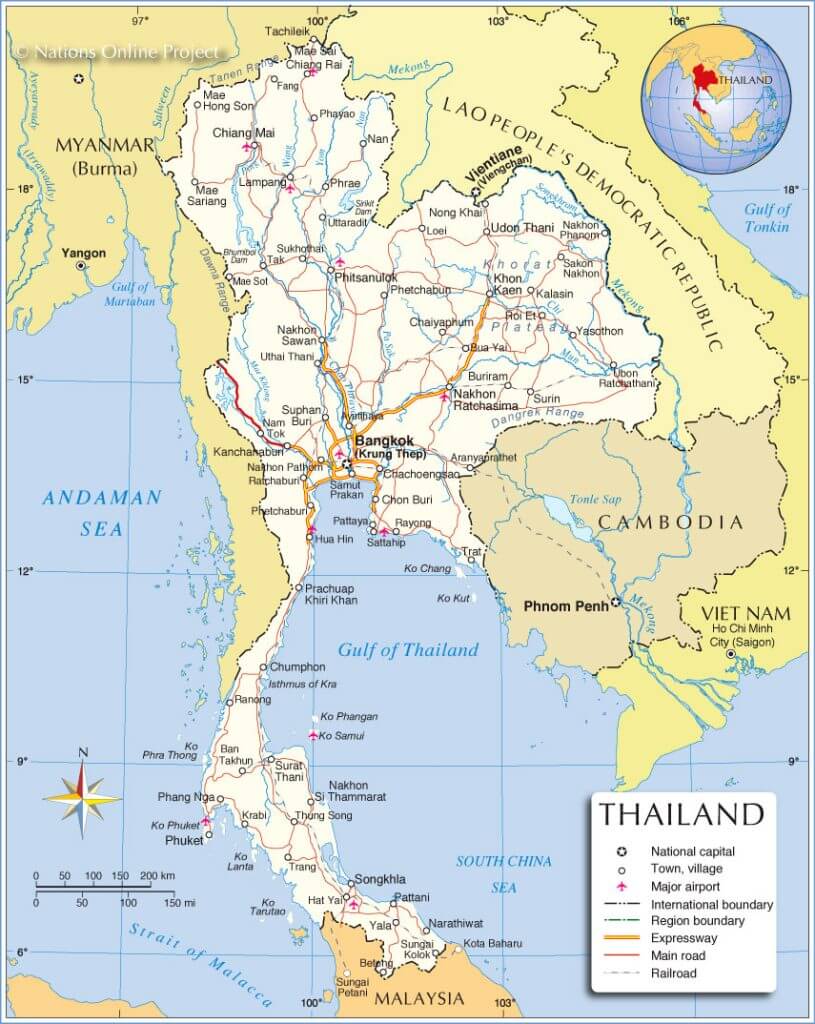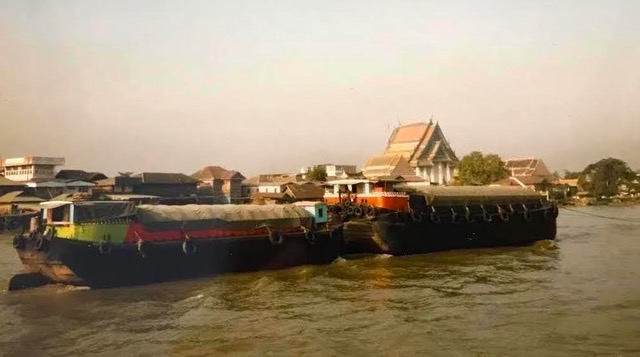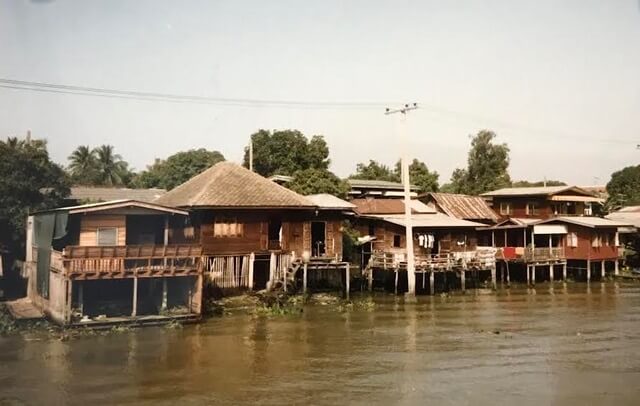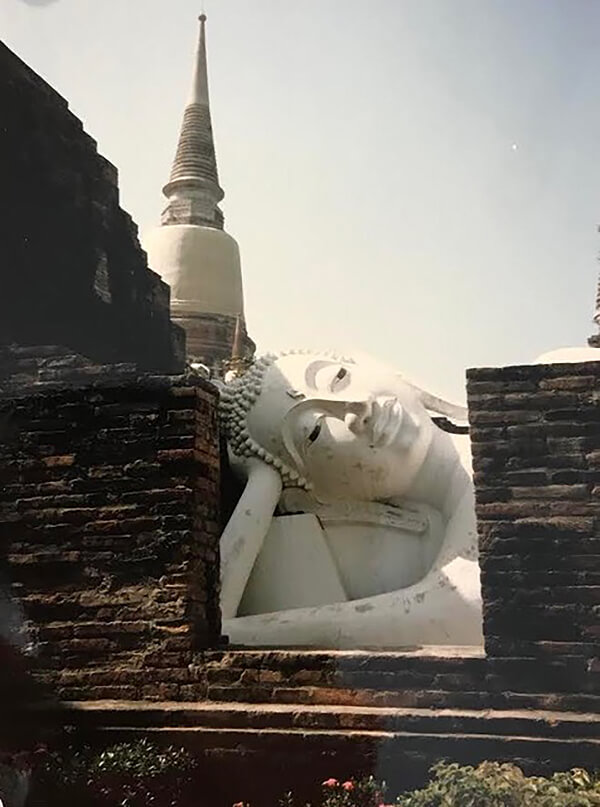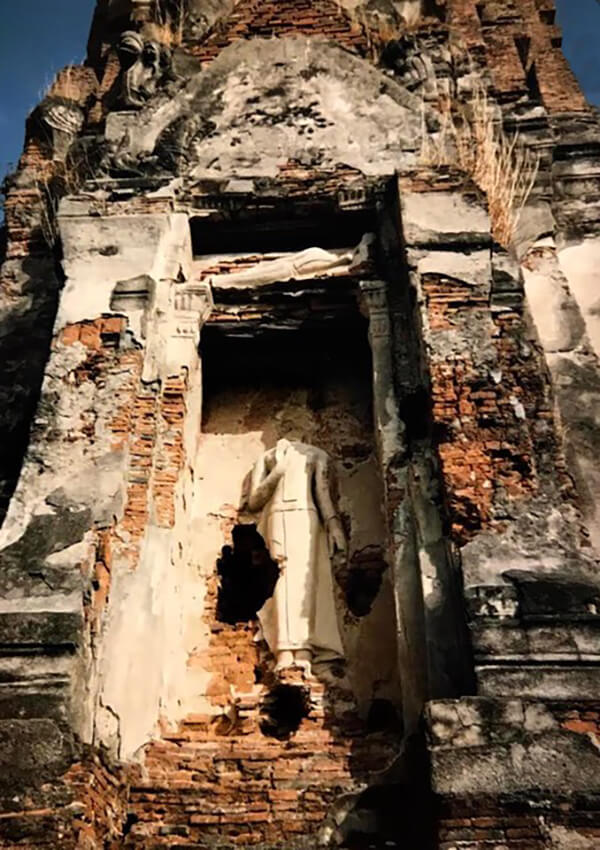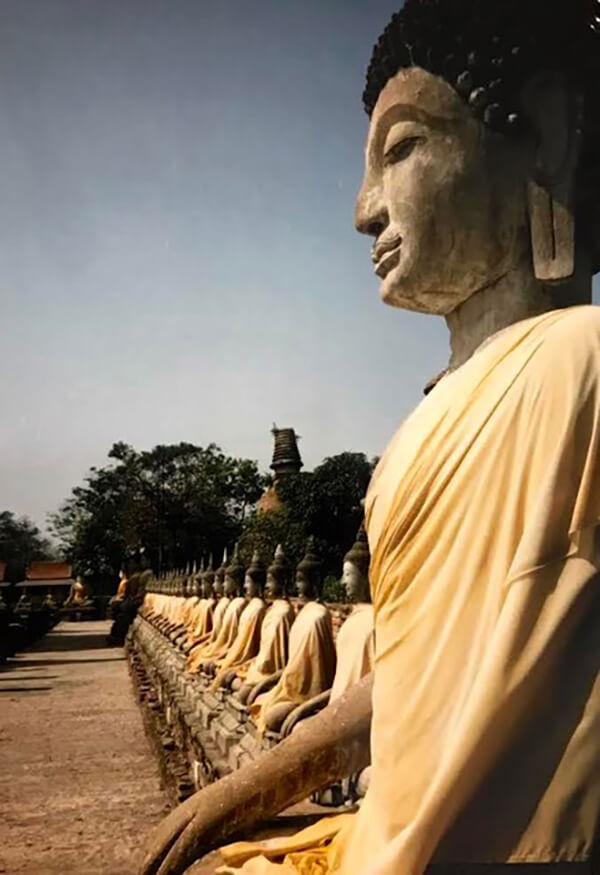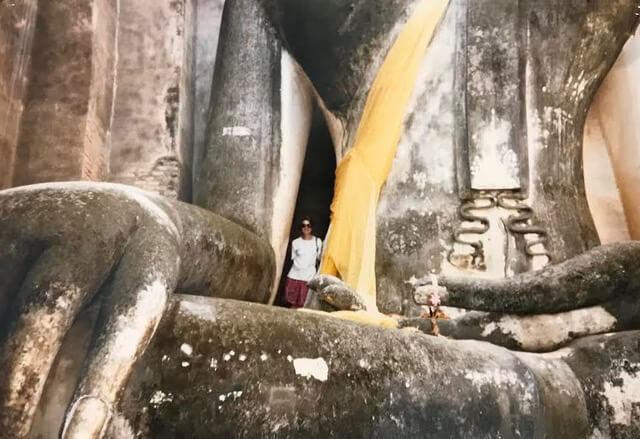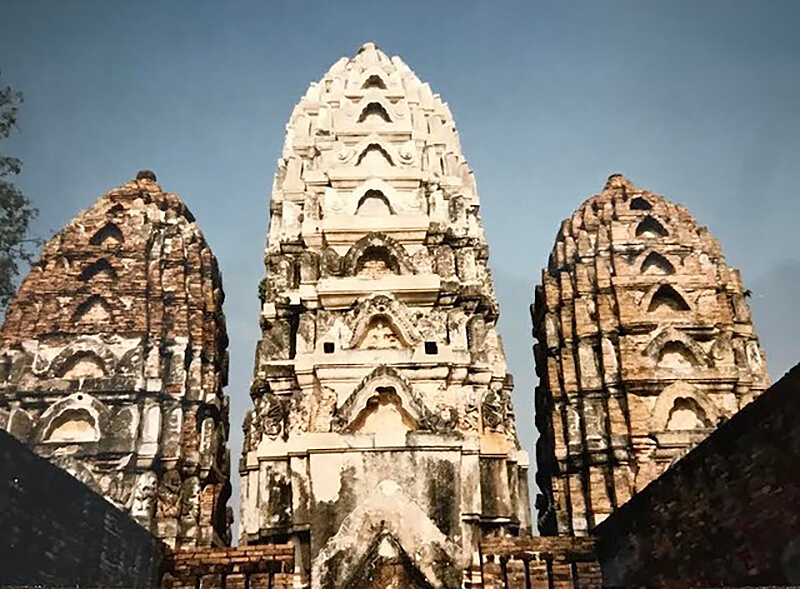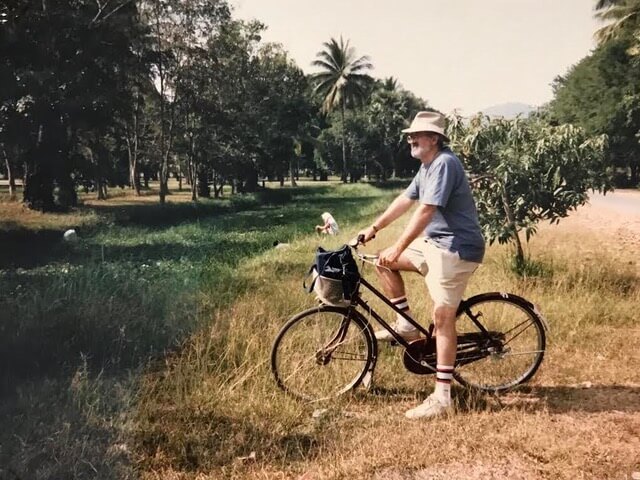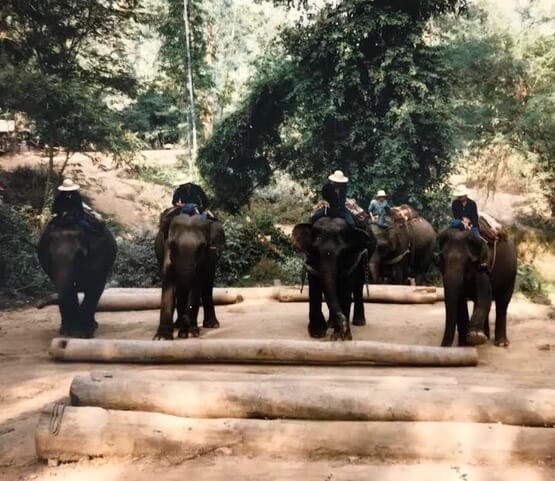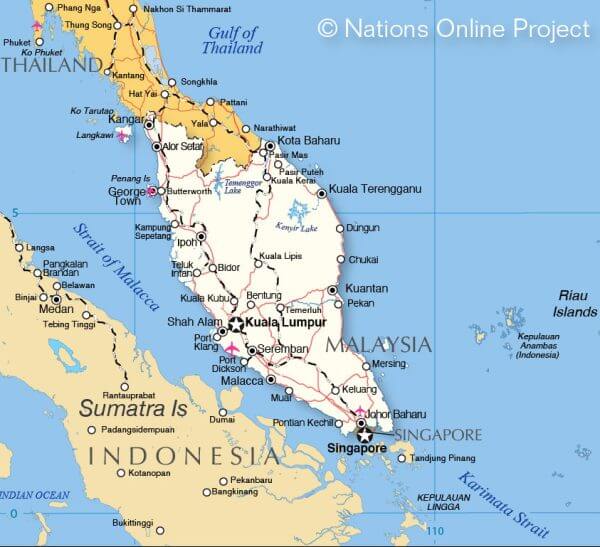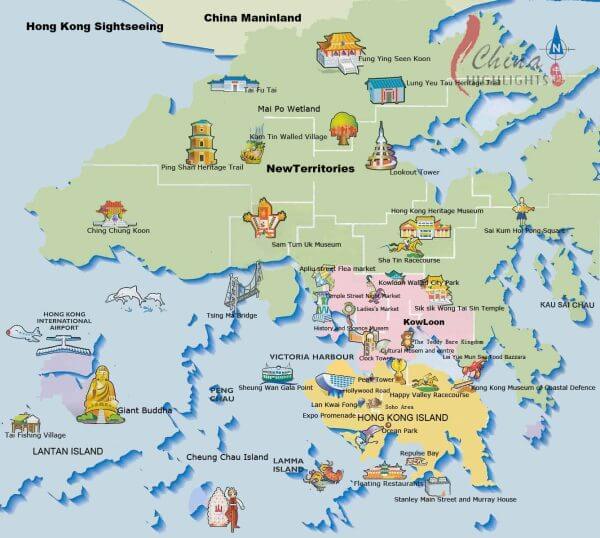#25: Touristing in Southeast AsiaAyutthaya, Sukhothai, Chiang Mai,Cameron Highlands, Hong Kong
All our lives, we’ve preferred to journey on our own, organizing travel and accommodations, making it up when things go wrong. Getting there is as much a part of the trip as the ultimate destination. We thrive on the challenge and the adventure. Here are some more trips we wrote home about while living in Laos. [You can click on the photos to enlarge them.]
December, 1991
Ayutthaya, Sukhothai and Chiang Mai, Thailand
We’re back home after many adventures on our Christmas trip, enjoying the cold weather (a high of 60 — not so cold for you folks who live in the East, but very cold for the tropics, where we have unheated houses — delicious!!).
We left Vientiane Dec. 12 and flew to Bangkok, where we ran some errands, sold copies of The Vientiane Guide and did some shopping. The highlight of the three days was the Weekend Market, which we’d heard about for months but had never been able to schedule before. It’s absolutely terrific, with wonderful plants, all sorts of clothes, fighting cocks (not so nice to see; their breasts were bloody and picked bare of feathers), pets (nicer to see: dogs, cats, birds and fish of all kinds). The market is famous for both high-end and less-expensive handicrafts. We admired an elaborate silver headdress and silver-bedecked bodice from the Akha tribe as well as a “rain drum” made of metal with wonderful decorations. We settled for some simple tribal necklaces and a Burmese lacquered box.
On Monday, the 16th, we began as the Thai have travelled for centuries, by boat. We’d hoped to be able to take a ferry on the Chao Phraya [“chow pry-ah”] River, but there seemed to be no ferries going as far as we wanted. So we took the Oriental Queen north to Ban Pa-In, just south of Ayutthaya. Operated by the famous Oriental Hotel, it was the start of a tour for their guests, but we hitched a ride for just the first four hours. We had seats on deck with grand views of the life of the river — barges, water taxis, temples, houses on stilts, etc. When we arrived, we discovered that we’d been misinformed. There was no ground transport from the dock to our hotel. Bo pen yang, as we say in Lao, “not to worry.” We got a ride with a local man in his very posh pickup truck, me squeezed into the tiny seat behind the driver, R in the front seat, luggage in the rear. Only 20 kilometers and fun.
Ayutthaya [“Aye-oo’-tie-ya”] was very interesting. The capital of Siam from the 13th to the 18th centuries, it was world-famous for its beauty and size. The Europeans who visited during that period compared it favorably to anything at home, often praising it in excess of their own cities. Now it’s all in ruins, but still 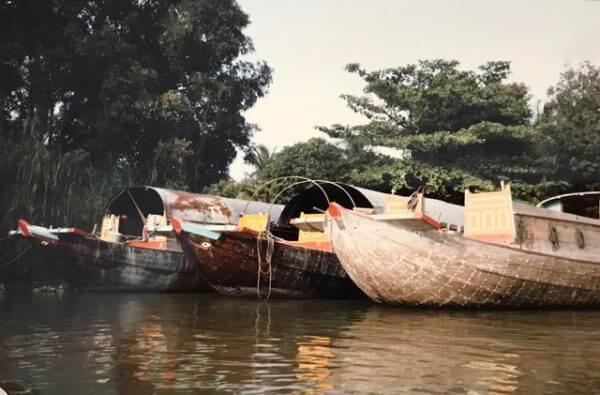 impressive. We toured most of the wats (temples — many of them still in use), the palace, and two museums. Ayutthaya is on an island formed by the confluence of three rivers, a naturally defensible position. We took a trip around the island in a long-tailed boat (a shallow-draft vessel with a movable outboard motor featuring a very long rod to the propeller which can be raised or lowered according to water depth). The experience made us appreciate an era when almost everyone travelled by watercraft, with many people even living on the water.
impressive. We toured most of the wats (temples — many of them still in use), the palace, and two museums. Ayutthaya is on an island formed by the confluence of three rivers, a naturally defensible position. We took a trip around the island in a long-tailed boat (a shallow-draft vessel with a movable outboard motor featuring a very long rod to the propeller which can be raised or lowered according to water depth). The experience made us appreciate an era when almost everyone travelled by watercraft, with many people even living on the water.
On the 18th, we went on the next leg by train — only second-class available, but we had reclining seats and fans (no air conditioning). In the cool season, it was fine. After a trip of c. 6 hours, we arrived in Phitsanulok, the stop nearest Sukhothai [“Soo’-koh-tie”] . 10:30 at night and impossible to find a conventional taxi, so we hired a converted pickup to take us to our hotel. This time, we rode on wooden seats in the rear with our luggage and cool breezes — glad to have our windbreakers handy, because it got chilly. I finally sat on the bed of the truck, fairly protected from the wind by the luggage and Russell’s legs. It was a beautiful night, and I wouldn’t have missed it for the world
We slept in the next day and then were up and at ’em to see the Siamese capital which preceded Ayutthaya. Unlike Ayutthaya, there is no modern city among the ruins. The new site is some miles down the road, so Sukhothai has been excavated and stabilized (as well as somewhat heavy-handedly “restored” in some places). We tootled around the ruins on bikes, stopping to take pictures here and there. Sukhothai was originally a Khmer/Hindu site which was taken over by the Buddhist Thais. They converted some of the temples and added new buildings in their own style. Many experts think this was the high point of the Thai civilization. It’s certainly impressive — even the city walls remain.
After three days in Sukhothai, we took an air-conditioned bus to Chiang Mai [“chahng-my”], a trip of some 6 hours. The bus was very comfortable, although there was no toilet like those on long-distance buses in the States. Bo pen yang — it stopped every hour or so, letting travelers buy snacks, visit the rest rooms (sometimes OK, sometimes not), and stretch their legs. Thailand is a vast plain from Bangkok to near Chiang Mai. The climb up into the hills and mountains was especially welcome. It became cooler (although it isn’t really hot this time of year) and more scenic.
We both found Chiang Mai to be a bit of a disappointment, as have friends from Bangkok and Vientiane. Chiang Mai used to be a very special place where a medieval walled city still functioned pretty much as it had for centuries. It had been the capital of a northern kingdom which wasn’t incorporated into Thailand until early in this century. As recently as the 60s and 70s, friends who lived or travelled there wrote back glowing reports of its beauty and exoticism. Now condos have come to Chiang Mai, and it’s basically been ruined, as local people were quick to tell us. Beautiful old teak mansions have been torn down in order to put up boxy high-rises, the air is polluted from traffic, and it’s mostly frustrating to get around.
 On the other hand, we were very pleased with our accommodations, a traditional Thai structure with modern bath but little else in the way of concessions to a foreign lifestyle. One of three structures in a compound bordering on a rice field with a village on the other three sides, it was sparsely but beautifully furnished with traditional Thai artifacts. We slept under a mosquito net with two comforters because it was so wonderfully cool. Our hostess was a Thai woman who has a restaurant and crafts gallery. Her preservation of these wonderful old houses has received much recognition. In fact, when we returned to Vientiane, we learned that her house and guesthouses are mentioned in Thai Style, a book which we have on our coffee table. It was a very peaceful and serene haven at the end of hectic days in the city.
On the other hand, we were very pleased with our accommodations, a traditional Thai structure with modern bath but little else in the way of concessions to a foreign lifestyle. One of three structures in a compound bordering on a rice field with a village on the other three sides, it was sparsely but beautifully furnished with traditional Thai artifacts. We slept under a mosquito net with two comforters because it was so wonderfully cool. Our hostess was a Thai woman who has a restaurant and crafts gallery. Her preservation of these wonderful old houses has received much recognition. In fact, when we returned to Vientiane, we learned that her house and guesthouses are mentioned in Thai Style, a book which we have on our coffee table. It was a very peaceful and serene haven at the end of hectic days in the city.
Handicrafts are a passion with us, and we saw exquisite examples with some surprises. The prices on items like silver Akha headdresses were much inflated over those we’d seen in Bangkok’s Weekend Market. Local merchants have discovered that tourists are willing to pay amazing sums. Another surprise was that a lot of the things for sale were really Lao. Sadly, given the current political situation in Burma and the nearby border, we also saw beautiful, antique lacquerware which had been carried across and sold for much-needed cash.
We had Christmas dinner at the Dusit Inn — a multiple course extravaganza, including turkey with all the trimmings and Christmas pudding, so we admit to taking advantage of what’s been introduced for tourists in the far north of Thailand.
The final highlight of our Chiang Mai stay was a drive north toward the Fang Valley (“fahng,” not the nickname for your neighbor’s dog). We got up quite early and travelled first to an elephant-training center, where we saw how the animals work singly and in tandem to handle huge teak logs. We also had a ride, and I fed a baby elephant, who was insistent but gentle with his rough trunk. It was a moving experience to be with these huge animals who were so skillful at work and playful in the river afterwards. My impression throughout was that the elephants had been trained with kindness by their Buddhist team-mates.
We continued northwards in the late morning, stopping at the Chiang-Dao caves, where we walked through caverns filled with Buddha images, some of them quite ancient. We ended up with a picnic beside a lake with fantastic rock formations all around.
After a week in the north, it was time to get on home, flying first to Bangkok and then to chilly Vientiane. Sweater weather!
August 1992
Cameron Highlands, Malaysia
The postcards we sent from the Malaysian Highlands should give you a good idea of what it looks like. More importantly from my viewpoint was what it felt like — cool and misty, such a wonderful change from hot and steamy Vientiane.
We left here on the 6th and flew to Bangkok, where we ran some errands. Among them, Russell’s laptop needed repairs after a power surge rendered it inoperable.
The next day, we flew to Kuala Lumpur. Despite the monsoon season, all our flights were relatively smooth. We’d decided to splurge for the two nights (one coming and one going) we were in KL, so we stayed at the Hotel Shangri-La. It features a gourmet deli, and we really drowned in chocolate truffles, fancy pastries and a picnic lunch of pastrami sandwiches for our drive up to the mountains the next day. The hotel has very nice restaurants which we also enjoyed, but the deli was the real treat for two folks living in the heart of SE Asia far from such goodies.
Before we left KL, we penetrated into the heart of Chinatown to the best artist supply store in the region. We purchased materials for the artists who are working on the next edition of the Vientiane Guide: tracing paper, professional markers, rubber cement and acetate. We could have spent hours and big bucks in that shop with all its wonderful papers, inks, paints, brushes, etc. As it was, we spent close to $100 of the Women’s International Group’s money.
We rented a car with driver (no U-drive available) and travelled five hours northeast into the Cameron Highlands, most of the time on a narrow, winding road that would have made you West Virginians feel right at home. We stopped at a huge cascading waterfall for our deli lunch and arrived mid-afternoon at the Merlin Hotel, part of a well-known chain. However, they must not have been maintaining this one, because its 1950s motel decor was worn and smelling of damp.
 So we hiked down the road to the Smokehouse Inn, listed in our guidebook as “tacky” and decided (a) it wasn’t, and (b) it suited us lots better. The oldest hotel in the Cameron Highlands, it was built between the wars, when they were first opening up the plateau to development. We shifted over the next day and enjoyed every minute in the Tudoresque inn with four-poster beds, Devonshire cream teas and Yorkshire pudding.
So we hiked down the road to the Smokehouse Inn, listed in our guidebook as “tacky” and decided (a) it wasn’t, and (b) it suited us lots better. The oldest hotel in the Cameron Highlands, it was built between the wars, when they were first opening up the plateau to development. We shifted over the next day and enjoyed every minute in the Tudoresque inn with four-poster beds, Devonshire cream teas and Yorkshire pudding.
Hiking and napping and reading and eating — that’s how we spent out time in the highlands, just what the doctor ordered. We hiked up to the cottage from which Jim Thompson, millionaire American founder of Thai Silk, disappeared in 1967, never to be seen again. 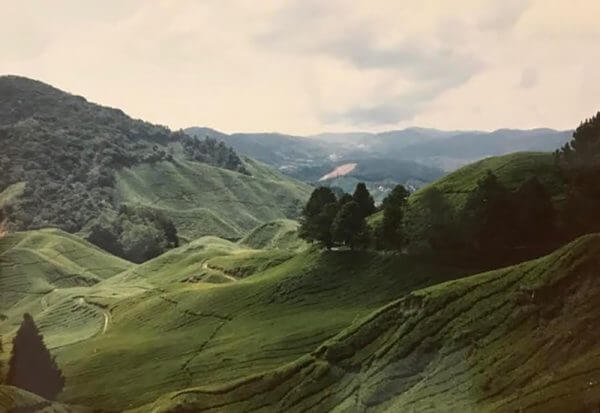 We also hiked down to the next town, and when it began to rain, we thankfully hired a taxi back up the mountain.
We also hiked down to the next town, and when it began to rain, we thankfully hired a taxi back up the mountain.
We toured the Boh (“Best of the Highlands”) Tea plantation and factory. The tea fields are so high (over 6500 feet) that those ladies earn every penny of the c. $20 per day for “plucking,” as it’s termed. The tea factory smelled wonderful, and we bought a tin of their best quality for breakfasts back home.
Another day, we rented a car with driver and went to the highest point on the Malay peninsula. What a view. While we were there, the mist came in, so we got to see it in two aspects. The government has telecommunications equipment up there. For the resident team, it must be like living on top of the world.
Thursday the 13th came very soon, and we headed back down the mountain on a rainy day with the air conditioning on to prevent windshield fogging. (I imagine it sounds strange to folks who live in a temperate climate, but that’s what you do in the tropics.) Anyway, it was a pretty chilly ride, but we had a good driver, and all went well. We purposely didn’t take a box lunch from the Smokehouse, so we could hit the Shangri-La deli again. We each had a sandwich with a side order of potato salad. Potato salad! We haven’t had that in over two years.
We spent the remainder of the afternoon shopping for various items on our list. KL has American-style drug stores, and it was fun just to wander around, never mind finding sensitive toothpaste. More errands in Bangkok — all we Vientiane residents leave home with long lists of things which are unavailable here. For us, a large part of that list is English-language books. In addition, we always buy presents for our household and office staff, as well as stuff like Mazola oil (only highly saturated coconut oil in Laos) and tomato soup.
Bad news once we got back to Bangkok: it was going to cost so much to fix R’s computer that he was better off buying a new one (but they’re very expensive in both Thailand and Laos). Luckily, we’ve since learned someone who’s leaving Vientiane has a high-powered Toshiba for sale.
All in all, a good trip with a good ending — cool climate, good food, daily hiking and excellent tea.
Early Fall, 1992
Hong Kong
September 24
As you may recall, we discovered that we share the exact same wedding date with Australian Ambassador Michael Mann and his wife, Monique. As we sat around our lunch table last Saturday, kicking around ideas to mark the occasion, I said, as a joke, “We could fly to Hong Kong for dinner.” Everyone’s eyes lit up a little, but we passed over the idea and decided on a small but elegant dinner at the Manns’ house.
[See Post #19, “Entertainments and Celebrations,” for an account of this party with photos.]
The next morning, Russell said, “I’ve been thinking about the Hong Kong idea. It’s a lot more special than one more Vientiane dinner party. Why don’t we consider it?”
We drove over to the Manns because our phone was out and discovered they’d been thinking about it too! Monique said that the twentieth anniversary should be really memorable. Russell said we’d all been working so hard and being so responsible that doing one fey thing to celebrate seemed the right thing to do. Michael said he’d love to just get away and have some fun for a couple of days, like a second honeymoon.
So we’re flying to Bangkok the night after our fancy dinner and on to Hong Kong the next day. We’ll stay in a nice hotel, eat some fun food and return on the Monday, which is a Lao holiday. I know it all sounds a bit irresponsible, but maybe you should do that every twenty years. Besides, Hong Kong isn’t as far from here as New York is from LA, so it’s not quite as bad as it sounds. We’ll send you a postcard from our middle-aged silliness. What will we be like when we’re in our dotage? Ballooning across Africa??
October 21
The start of the trip had a set-back when we opened our suitcases to find them filled with mold, but fortunately that was the day before departure, so we scrubbed them out and put them in the sun. The dry season will start soon, so we can give up this sort of thing for six months, thank God.
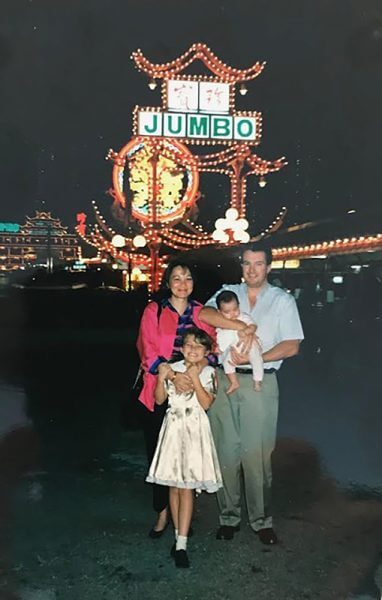 In Hong Kong, our Hotel Mandarin room featured a view of the water. We arrived in time for a dim sum tea, a significant treat since I’d had my very first taste in Hong Kong almost 30 years ago. That night, we had dinner at one of the floating restaurants in Aberdeen — boy what a change. Thirty years ago, Aberdeen was a dark fishing village with sampans plying dark waters. Now it’s full of high-rise apartment buildings with a fancy yacht basin lit up like a carnival.
In Hong Kong, our Hotel Mandarin room featured a view of the water. We arrived in time for a dim sum tea, a significant treat since I’d had my very first taste in Hong Kong almost 30 years ago. That night, we had dinner at one of the floating restaurants in Aberdeen — boy what a change. Thirty years ago, Aberdeen was a dark fishing village with sampans plying dark waters. Now it’s full of high-rise apartment buildings with a fancy yacht basin lit up like a carnival.
We really enjoyed traveling with the Manns. Not only did Monique and Michael go, but so did their daughters, aged 3 months and 8 years. Both were beautifully behaved.
The next night, we had a scrumptious dinner in the Mandarin’s best restaurant, all dressed up and taking a long time, laughing over funny stories from everyone’s life.
Sunday morning, we took the Star Ferry to Kowloon. As we were waiting to board, a voice said, “My God, it’s Nancy Swing!” I turned around, and there was an old friend, neighbor and colleague from Washington, DC days. She was returning to Massachusetts, where she now lives, after a tour of China. This is truly a very small world.
That afternoon, we flew back to Bangkok, with Russell and the Manns returning to Vientiane the next morning. I stayed on the better part of the week to take care of projects for the Vientiane Guide and Russell’s client-ministry.
***
We’ve remained in touch with the Manns down through the years, later hosting them in our Italian home and visiting them now and again in Southeast Asia, Michael’s multi-faceted career-base. As I was writing this in March, we four were planning a 50th anniversary celebration in mid-Pacific Hawaii. But April brought a serious health challenge for one of us, with no air travel permitted during the next six months. We had to break off negotiations with Waikiki hotels, but we’re hoping to reschedule a milestone-marking event another time. Fingers crossed…

COMING NEXT MONTH
Touristing from Southeast Asia
Australia and New Zealand

LET ME HEAR FROM YOU.
Please take a moment to share your thoughts.
Your comments help make the blog better, and I always answer.
* * *
If you enjoyed reading this post, I hope you’ll SUBSCRIBE by clicking on the button below. Every month, when I post a new excerpt from my life overseas, you’ll get an email with a link so you can read the next installment. Subscription is free, and I won’t share your contact information with anyone else. Your subscribing lets me know you’re reading what I write, and that means a lot.

